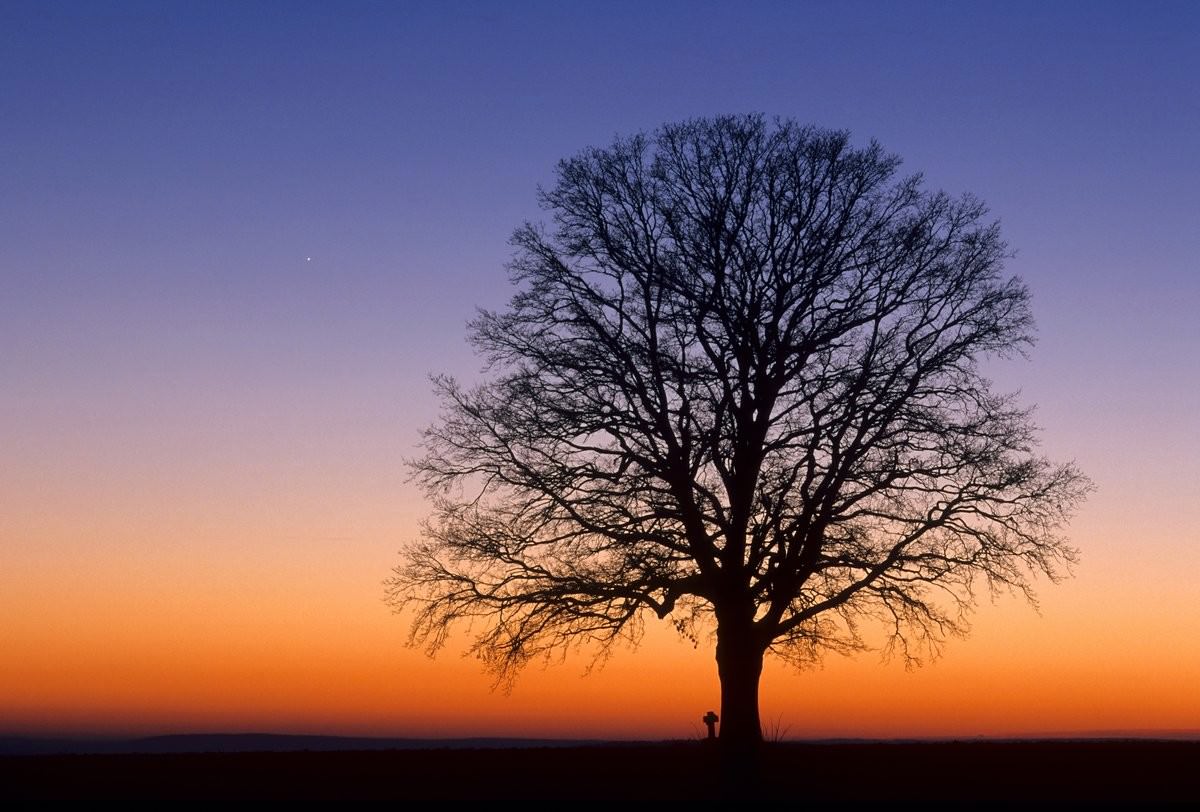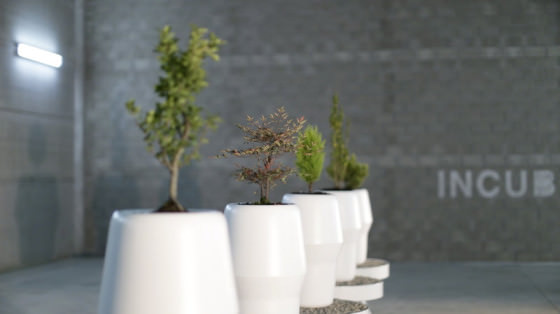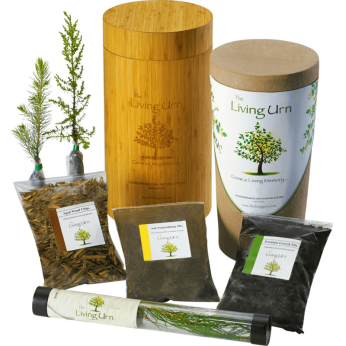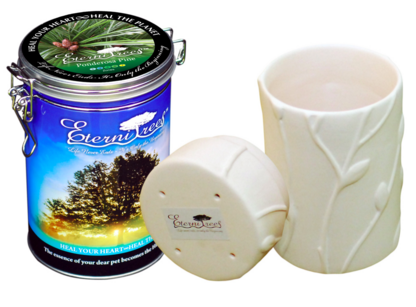From the Ashes: 3 Companies That’ll Turn Cremains into a Tree
Just because you’re dead doesn’t mean you should stop caring about the Earth.
From the Ashes: 3 Companies That’ll Turn Cremains into a Tree
Just because you’re dead doesn’t mean you should stop caring about the Earth.

If you or your loved ones want to be environmentally friendly, even in death, you have a few options and considerations: Green burials – the practice of “returning a person to the earth” by burying in a biodegradable casket, without embalming fluid or a concrete vault – is legal in all 50 states but saddled with rules and regulations governing how and where you can bury. Not all cemeteries allow green burials (but you can find one near you here). And when deciding between burial versus cremation, consider the issue of dwindling cemetery space: It’s estimated that between 2024 and 2042, about 76 million Americans will reach the average life expectancy of 78 years; when they pass on, they’ll require burial space roughly the size of Las Vegas.
For people who choose cremation, several companies have created biodegradable urns that, when combined with specific soil mixtures, use cremains to help grow a tree. In a way, these products hark back to a time before the creation of the “traditional” burial system – when our ancestors’ remains went straight into the ground and provided sustenance for all sorts of plant life – but in a 21st century, space-saving, environmentally-friendly manner. Here are three companies that have their own particular products to help you continue the cycle of life.
Bios Urn and Incube
Bios, a Spanish company who wants to “convert cemeteries into forests,” recently raised more than €73,000 (about $82,800) through a Kickstarter campaign for their new product, the Bios Incube. This gadget pairs with the company’s existing biodegradable urn and tree-growing kit to allow you to grow a seedling in your home, rather than find a burial spot. Incube is smart: It tracks your plant’s temperature, electrical conductivity, solar irradiance, and soil humidity; using that data, it automatically waters. Roger Moliné, the COO and co-founder, tells Modern Farmer in an email says he came up with the idea after receiving requests from a number of customers who complained of limited cemetery space or having no place to plant their biodegradable urn.
The Incube can water the tree for up to 20 days before you need to refill it, and connects to your smartphone or tablet through an app to keep you alerted to what’s happening with your seedling.
Bios will begin taking pre-orders next month on their website and expects to start shipping the Incube to their Kickstarter funders by the end of the year, with a general release tentatively scheduled for sometime in 2018. The company is also working on creating Bios Incube centers where people can have their trees incubated for them.
“We really believe it can help people who live in big cities with limited space for burials, and for those who want to take on an active role in growing something from just a seed,” says Moliné. “We decided it was okay to bring the process of death and dying up to speed with 21st-century demands and requests. We also wanted to create something that was environmentally friendly, and could encourage even those who don’t garden or aren’t used to growing plants or trees, to take on a new activity and find peace in a different practice.”
Bios Urn: $145 (choice of a five types of trees, including maple, pine, ash, gingko, and beech)
Bios Incube: Tentatively priced at $550 (includes a free Bios Urn)

The Living Urn
Based in Colorado, The Living Urn‘s system includes a biodegradable urn packaged in a handmade bamboo container, with a seedling, wood chips, a proprietary soil mix, and an ash-neutralizing agent that helps counteract the chemical properties of cremated remains to produce a balanced growing environment. According to co-founder Mark Brewer, the company provides seedlings – with a wide range of between 15 and 20 choices of tree types based on the customer’s growing zone – instead of seeds, which helps ensure you’ll actually be able to grow the tree, as seed germination can be tricky for amateurs.
Founded by three life-long friends, the idea for the product was initially conceived by another of the company’s partners, Brandon Patty, following the death of a friend. Patty wanted to honor his memory by planting a tree using his cremains. A few years later the three entrepreneurs, who all had an environmentalist bent, began working on the idea, with the help of arborists, soil scientists, and eco-friendly manufacturers. After about a year-and-a-half, the trio created to The Living Urn. They have also added a version for pets.
“We feel lucky to have such a great product and are excited to get the word out and have more and more families be made aware of this uplifting option that’s available to them,” says Brewer in an email.
The Living Urn: $135 (with choice of tree) or $119 without seedling
Pet version: $119 (with choice of tree) or $99 without seedling

EterniTrees Biodegradable Urn
EterniTrees, which is based in Oregon, uses a proprietary growing medium that helps release beneficial plant nutrients found in cremated ashes. (On their own, cremains aren’t actually plant friendly.) The urn holds about a cup of ashes so there’s the option of planting several trees using the cremains, scattering some of the ashes, or memorializing them in some other way. The company offers a choice of around 15 tree types based on your growing area, as well as a “Personal Choice” urn that allows you to locally source the seeds you choose to germinate.
If the seed doesn’t grow or an animal destroys the seedling, the company will send you more seeds and growing medium, or an actual seedling if seasonable available, for free.
Eternitrees Biodegradable Urn: $98 (includes choice of tree type)
Pet Version: $98 (includes choice of tree type)

SaveSave
Follow us
This work is licensed under a Creative Commons Attribution-NoDerivatives 4.0 International License.
Want to republish a Modern Farmer story?
We are happy for Modern Farmer stories to be shared, and encourage you to republish our articles for your audience. When doing so, we ask that you follow these guidelines:
Please credit us and our writers
For the author byline, please use “Author Name, Modern Farmer.” At the top of our stories, if on the web, please include this text and link: “This story was originally published by Modern Farmer.”
Please make sure to include a link back to either our home page or the article URL.
At the bottom of the story, please include the following text:
“Modern Farmer is a nonprofit initiative dedicated to raising awareness and catalyzing action at the intersection of food, agriculture, and society. Read more at <link>Modern Farmer</link>.”
Use our widget
We’d like to be able to track our stories, so we ask that if you republish our content, you do so using our widget (located on the left hand side of the article). The HTML code has a built-in tracker that tells us the data and domain where the story was published, as well as view counts.
Check the image requirements
It’s your responsibility to confirm you're licensed to republish images in our articles. Some images, such as those from commercial providers, don't allow their images to be republished without permission or payment. Copyright terms are generally listed in the image caption and attribution. You are welcome to omit our images or substitute with your own. Charts and interactive graphics follow the same rules.
Don’t change too much. Or, ask us first.
Articles must be republished in their entirety. It’s okay to change references to time (“today” to “yesterday”) or location (“Iowa City, IA” to “here”). But please keep everything else the same.
If you feel strongly that a more material edit needs to be made, get in touch with us at [email protected]. We’re happy to discuss it with the original author, but we must have prior approval for changes before publication.
Special cases
Extracts. You may run the first few lines or paragraphs of the article and then say: “Read the full article at Modern Farmer” with a link back to the original article.
Quotes. You may quote authors provided you include a link back to the article URL.
Translations. These require writer approval. To inquire about translation of a Modern Farmer article, contact us at [email protected]
Signed consent / copyright release forms. These are not required, provided you are following these guidelines.
Print. Articles can be republished in print under these same rules, with the exception that you do not need to include the links.
Tag us
When sharing the story on social media, please tag us using the following: - Twitter (@ModFarm) - Facebook (@ModernFarmerMedia) - Instagram (@modfarm)
Use our content respectfully
Modern Farmer is a nonprofit and as such we share our content for free and in good faith in order to reach new audiences. Respectfully,
No selling ads against our stories. It’s okay to put our stories on pages with ads.
Don’t republish our material wholesale, or automatically; you need to select stories to be republished individually.
You have no rights to sell, license, syndicate, or otherwise represent yourself as the authorized owner of our material to any third parties. This means that you cannot actively publish or submit our work for syndication to third party platforms or apps like Apple News or Google News. We understand that publishers cannot fully control when certain third parties automatically summarize or crawl content from publishers’ own sites.
Keep in touch
We want to hear from you if you love Modern Farmer content, have a collaboration idea, or anything else to share. As a nonprofit outlet, we work in service of our community and are always open to comments, feedback, and ideas. Contact us at [email protected].by Andrew Amelinckx, Modern Farmer
April 29, 2016
Modern Farmer Weekly
Solutions Hub
Innovations, ideas and inspiration. Actionable solutions for a resilient food system.
ExploreExplore other topics
Share With Us
We want to hear from Modern Farmer readers who have thoughtful commentary, actionable solutions, or helpful ideas to share.
SubmitNecessary cookies are absolutely essential for the website to function properly. This category only includes cookies that ensures basic functionalities and security features of the website. These cookies do not store any personal information.
Any cookies that may not be particularly necessary for the website to function and are used specifically to collect user personal data via analytics, ads, other embedded contents are termed as non-necessary cookies.
Hi, i am launching a campaign called “Treeincarnate.me” med May 2019 to create awareness and interest for Treeincarnation the process of transforming lifeless human and pet ash into magnificent living trees. https://www.youtube.com/watch?v=PgB50Rfl4K0 i have even rewritten Imagine 🙂
i told my kids that i wanted a tree burial, and found what i was looking for. the price was 119.00 not counting the price of the tree, but it stated there is a place in tennesse or ohio that you can be placed with out worry you would be cut down. .
looking for a garden to plant a tree with the ashes in NJ. Like to visit the sight
i dont want all of my ashes to become a tree just most, how much is needed? right now i weigh 148 and am 68 inches. i want some of them spread as well. just curious
What is the process? Is the urn provided to the mortician by the family, body cremated, added to urn, and handed back to family? How long is the tree seed viable before planting? Where do you plant? Anywhere? Or are there legal considerations?
These are all great biodegradable urn options if you’re in the USA. If you are in the UK, BloomUrn offer a beautiful ashes to flower tree bio urn that is easy to use. Go now and have a look at BloomUrn.co.uk